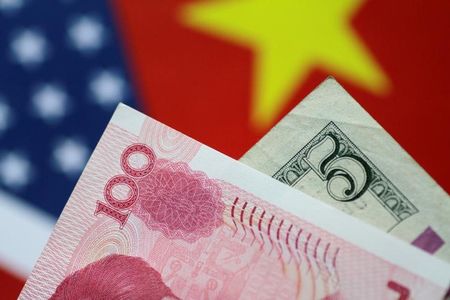Forex
Asia FX weakens as dollar recovers amid waning rate cut cheer

Investing.com– Most Asian currencies retreated on Friday as the dollar recovered a measure of recent losses after a string of Federal Reserve officials warned that bets on interest rate cuts may be premature.
While the greenback was still headed for some weekly losses, it was trading well above a one-month low hit on Thursday. U.S. Treasury yields also rebounded, pressuring risk-driven markets.
Regional factors also weighed on Asian currencies, as economic data from China and Japan underwhelmed.
Chinese yuan weak amid mixed economic prints
The Chinese yuan’s pair rose 0.1%, moving back to six-month highs above 7.22.
Economic readings from the country continued to offer middling signals on an economic recovery. Data on Friday showed grew more than expected in April.
But other readings showed growth in slowed sharply, while a decline in Chinese accelerated last month.
Chinese also grew less than expected in April, while fell from a seven-month high, but still remained relatively high.
The readings presented a mixed outlook for Asia’s biggest economy. They also came after the U.S. imposed higher tariffs on key Chinese industries, sparking fears of a reignited trade war between Beijing and Washington.
Concerns over China weighed on other currencies with trade exposure to the country. The Australian dollar’s pair fell 0.2%, while the South Korean won’s pair rose 0.7%.
The Singapore dollar’s pair rose 0.1% after the island state’s grew at a slower-than-expected pace in April, and also contracted sharply from last year.
remove ads
.
Weakness in the Japanese yen deepened after weaker-than-expected gross domestic product data for the first quarter. The pair rose 0.3% and was close to breaking above 156, extending sharp overnight gains.
Dollar recoups most weekly losses as Fed downplays rate cuts
The and rose 0.2% each in Asian trade, extending an overnight rebound from one-month lows.
The dollar’s recovery came as several Fed officials, specifically members of the bank’s rate-setting committee, said that they needed much more confidence that inflation was coming down, beyond some easing inflation in April.
This saw traders scale back bets on a September rate cut, albeit slightly, according to the .
Still, the dollar was set to lose about 0.7% this week, following some softer-than-expected data for April. The reading, coupled with soft data pushed up hopes that inflation will cool in the coming months.

 Forex3 years ago
Forex3 years agoForex Today: the dollar is gaining strength amid gloomy sentiment at the start of the Fed’s week

 Forex3 years ago
Forex3 years agoUnbiased review of Pocket Option broker

 Forex3 years ago
Forex3 years agoDollar to pound sterling exchange rate today: Pound plummeted to its lowest since 1985

 Forex3 years ago
Forex3 years agoHow is the Australian dollar doing today?

 Cryptocurrency3 years ago
Cryptocurrency3 years agoWhat happened in the crypto market – current events today

 World3 years ago
World3 years agoWhy are modern video games an art form?

 Commodities3 years ago
Commodities3 years agoCopper continues to fall in price on expectations of lower demand in China

 Economy3 years ago
Economy3 years agoCrude oil tankers double in price due to EU anti-Russian sanctions

























